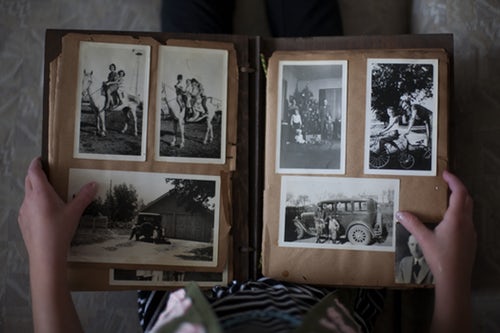 by Debbie Hommel, ACC/MC/EDU, CTRS
by Debbie Hommel, ACC/MC/EDU, CTRS
One of the easiest and most effective activities for the activity professional to conduct is reminiscing. Long term memories are a known strength in elders of all functional levels and for many, recalling experiences from the past is an accomplishment and a source of joy. Interestingly enough, reminiscing has only been viewed as a positive practice since the 1950’s. Prior to that, looking back was seen as a negative symptom of “old age”. Erik Erikson, the psychologist who developed the Eight Stages of Man, defined the importance of looking back and reflecting on one’s life in his final stage of man – Despair vs. Integrity. It was the work of Erikson and others who identified the benefits of this practice which has led to its accepted use today.
Reminiscing is simply defined as recollecting memories of oneself in the past. The important feature of this is that the memories are as the individual remembers them, from their own perspective, and their own truth. It is not unusual for stories to become embellished and negative details omitted over time, as we like to remember things as we want to remember them. A good example is the fishing story. The first time a fisherman tells the story about the fish he caught, the fish is about 12 inches long. In repeated telling of the story, the fish gets bigger and bigger. In reminiscing, that’s the right of the person telling the story as it is as they remember it. Correcting the individual or stating facts to dispute the story do not contribute to the positive memory sharing in reminiscing.
Reminiscing Therapy is a process which requires a trained professional working with clients selected for a particular reason and treatment goals defined. The activity professional practices simpler reminiscing which focuses on the enjoyment and shared camaraderie of common life experiences. The benefits of reminiscing are abundant and include increased socialization, reduction of boredom, re-interest in life events, reduced feelings of depression, appreciation of past life experiences, cognitive stimulation and strengthening of sense of self. There have been multiple studies conducted on reminiscing with the elderly which confirm positive experiences in reminiscing can improve in quality of life.
The activity schedule often defines formal reminiscing programs where a particular topic is defined to discuss. Topics can be introduced seasonally and follow a program theme. For example, during February – topics can include first loves or first dates which would coordinate with Valentine’s Day. The topic can be introduced through visuals or tactile items. In a higher functioning group, the conversation may take off quickly. Additional props and appropriate cuing may be needed to generate related memories related to the topic for the more impaired individual. The topic can be introduced through a reminiscing basket which has multi-sensory cues related to the topic. The reminiscing basket is similar to a theme sensory basket except it may have more items for review or to discuss. A reminiscing basket for Valentine’s Day would include props focusing on all the senses including vintage valentines and vintage photos of couples for visual stimulation; love songs from the era of the population for auditory stimulation; a decorative valentine candy box with velvet or satin to feel for tactile stimulation; and scents of roses, chocolate or perfume from the era of the population for olfactory stimulation. For higher functioning elders, the items may be placed on the table and the conversations will often take a life of their own. For the more impaired population, the items may be introduced one by one, with appropriate cuing and questions. Sometimes the group discussion goes in a completely different direction than planned and that is ok. Sometimes sad memories and tears are shared, which is ok too. All memories and emotions should be validated. In many cases, group members provide comfort to the person and knowing that others have experienced the same challenges provides additional solace.
There are a number of reminiscing focused games which generate discussion on various topics. Some items are sold as formal games through activity supply companies and others can be created with materials accessible to the activity professional. Such games include:
– “Conversation Ball” or “Toss and Talk Ball” where specific topics are written on a beach ball. The ball is tossed from person to person. When the person catches the ball, they discuss the topic where their hand has landed on the ball.
-“Bucket of Memories” where topics are written on ping pong balls. The individual reaches into the bucket and they discuss the topic on the ping pong ball they pull out.
-“Would you rather…” presents various questions on life experiences such as “would you rather have a teacher that was very strict and you learned a lot or would you rather have a really nice teacher but did not learn as much”. The participants discuss their choice and it is often related to life experiences on the subject.
-“Roll an Emotion” which is where you associate an emotion with the number on a die. For example, one would be happy, two would be excited, three would be angry, etc. The participant rolls the die and then shares a memory associated with that emotion.
Leading and facilitating reminiscing programs comes easy for some but requires practice for others. The group leader needs to develop appropriate questioning abilities. Cuing and questioning should be personable, conversational and tailored to the individual. The group leader needs to be sensitive to non-verbal responses of the participants and ensure feelings are acknowledged. The group leader facilitates an atmosphere where all memories are accepted with respect and minimizes negative judgement amongst the participants. If a topic goes astray into a very personal, negative experience or conflicts erupt– it may be best to change the subject and address it personally with the individuals in private. Practice makes perfect in group leadership. Reminiscing can be one of the more rewarding experiences for the elder as well as the activity professional.
“To reminisce with my old friends,
a chance to share some memories,
and play our songs again.”
Ricky Nelson
Resources for Reminiscing
Memories are Made of these Pinterest Page
Facilitating Reminiscing Programs with the Elderly – Independent Study Program
Eight Hour NCCAP Approved Independent Study Program

